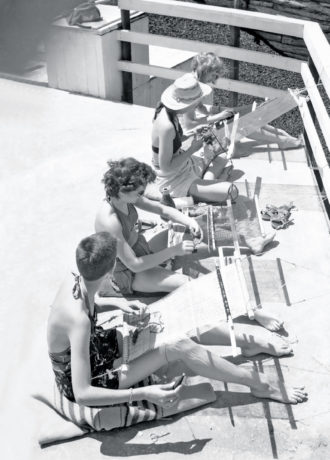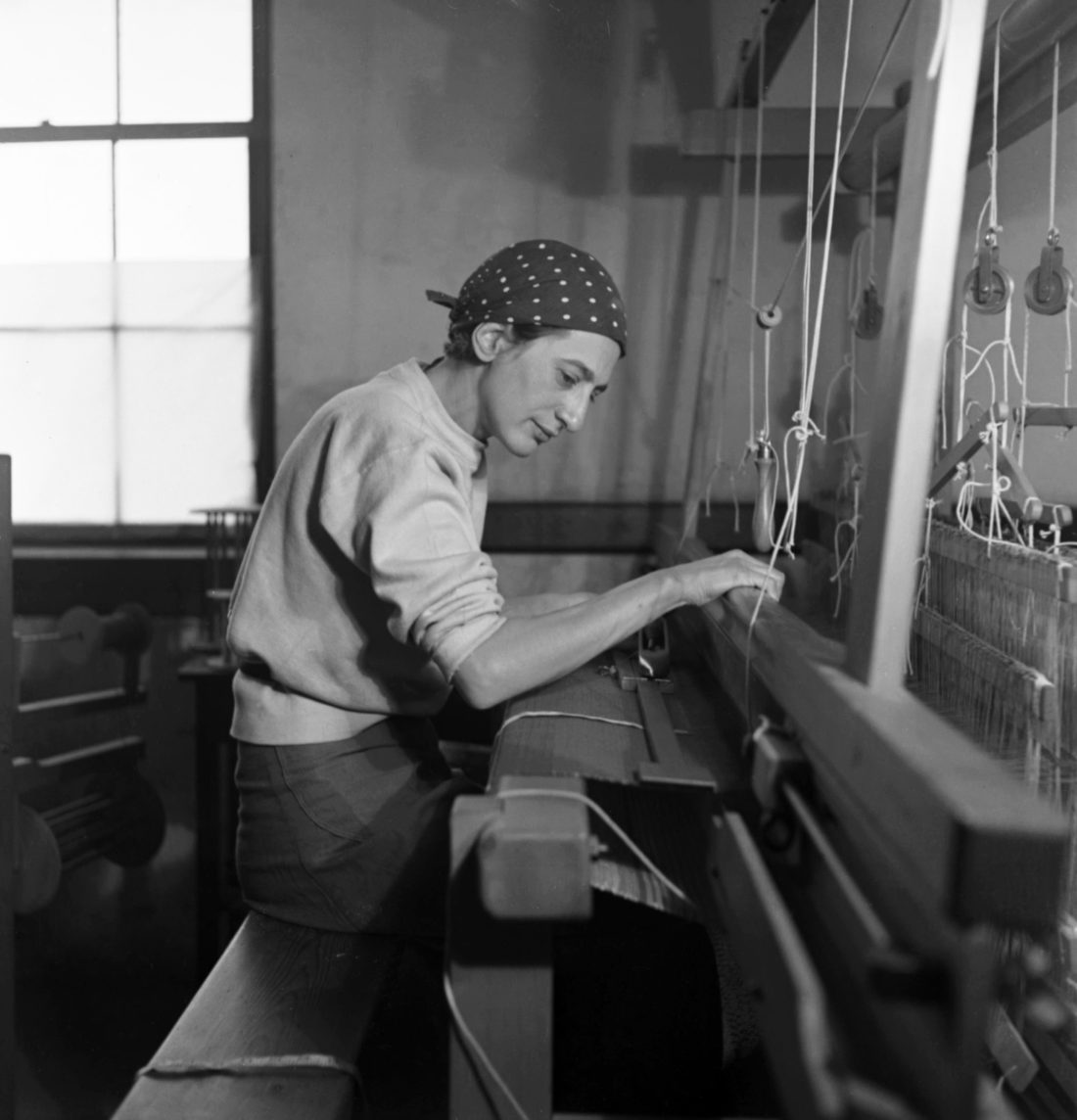Rodney Dangerfield is famous for his catchphrase “I don’t get no respect.” But individuals previously involved with the weaving program at the former Black Mountain College could have uttered the same line with comparable justification.
Celebrated textile artist and printmaker Anni Albers started the BMC weaving program in 1934, and it lasted until the school closed in 1957. However, for various reasons, art historians have long ignored the medium, including previous scholarship and exhibitions about BMC.
“Textiles have always had an in-between place, I would say, when it comes to art museums,” says Julie J. Thomson, a Black Mountain-based independent scholar and curator. “Some art museums don’t have textile departments or a textile curator. So, unfortunately, I think the subject’s been neglected because it does fall between art and craft — but it is also both art and craft, and design.”
On Friday, Sept. 29, a new exhibit, “Weaving at Black Mountain College: Anni Albers, Trude Guermonprez, and Their Students,” opens at BMC Museum + Arts Center, in downtown Asheville. Co-curated by Thomson and her Boston-based colleague, Michael Beggs, the project seeks to elevate this largely hidden side of the school’s history.
‘What are they doing?’
The seed for “Weaving at Black Mountain College” was planted while Thomson was curating the 2017 exhibition “Begin to See: The Photographers of Black Mountain College.”
“Seeing photographs of people weaving at Black Mountain College just made me really wonder, ‘What are they doing?’ And, ‘How does a person weave?’” Thomson recalls.
As she delved further into the topic and saw the potential for an exhibition, it became clear that she’d need a fellow scholar well-versed in the history of Albers. Beggs was her top choice. A fellow independent scholar and curator who worked at the Josef and Anni Albers Foundation, Beggs has written extensively about the Alberses and BMC, resulting in three books over the past decade.
“Michael has studied design and architecture,” Thomson says. “And I’m trained as an art historian, but I’m also always pursuing how artists become the artists they become.”
As she and Beggs began their research, they soon discovered that over 10% of all BMC students took a weaving or textile design class. Learning that these courses were a far more significant part of the art and design curriculum than previously thought led to a wealth of new scholarship regarding well-known BMC alums.
The enrollment discovery, Thomson explains, “allows us to look at some of the most famous Black Mountain College artists from a new medium than we have.”

As an example, she points to painter and graphic artist Robert Rauschenberg, who she and Beggs discovered, studied under Trude Guermonprez. “[Rauschenberg] actually took a textile design class and goes on to design so many dance costumes as well as works with fabric in them,” Thomson says. “Some of those are artworks, and some of them are backdrops for dancing.”
Thomson adds that a number of male students studied weaving and textile design with Anni Albers, then went on to study architecture. And that the legacy of Guermonprez, who eventually started a weaving program at the California College of Arts and Crafts (now known as the California College of the Arts), can be seen through the creations of Rauschenberg and her other pupils. This network of influence makes it all the more confounding that the impact of BMC’s weaving history has remained hidden for so long.
“Both Michael and I think that the gendered nature of weaving has led to the oversight of delving into this,” Thomson says. “But the fascinating thing is that, at Black Mountain College, weaving and textile design was studied and even taught by both men and women. [The school] was not paying attention to that previous gendering of weaving.”
Weaving renaissance
The co-curators spent four years working on the exhibit and its accompanying book by the same name. The exhibit features over 100 textiles and what Thomson calls “material studies,” including rare, archival photographs.
“We’re showing weavings and textiles that have never been seen since the Black Mountain College days,” Thomson says. “Don Page’s graduation portfolio is one of those.”
The exhibit and book also feature work and writing by contemporary artists, including Kay Sekimachi, Jen Bervin, Porfirio Gutiérrez, Susie Taylor and Bana Haffar. And a few weeks after the exhibit opens, UNC Asheville will host the 14th Annual ReVIEWING Black Mountain College conference, Friday, Oct. 13-Sunday, Oct. 15. This year’s theme is “Material + Structure.”
Beggs and Thomson will speak at the conference. And the keynote address will feature Brenda Danilowitz, an art historian and chief curator at the Josef and Anni Albers Foundation, in conversation with Erica Warren, editor of Craft Quarterly. Danilowitz and Warren also have essays in the book.
“It’s a great opportunity to hear the scholarship from people who have written in our book and to ask more questions,” Thomson says. “Any of these [weaving] students could be researched further. The people who taught weaving at Black Mountain College could also be researched further. So, Michael and I see this as the beginning, hopefully, of opening a new path into studying the weavers and textile designers at Black Mountain College.”
Additional speakers include family members of BMC weavers, and Thomson is particularly excited to have numerous younger scholars presenting.
“There’s also just the cross-pollination of being together for a few days, eating lunch together like they did at Black Mountain College,” she says of the upcoming gathering. “New connections or new ideas or new thoughts come out of the conference.”
Tying it all together is the personal artistic growth that the co-curators have experienced: Amid their research, both have learned to weave. Beggs picked up the craft during his five years at the Albers Foundation, and Thomson has taken classes at the Craft Center at N.C. State University, the John C. Campbell Folk School and with Heritage Weavers & Fiber Artists in Hendersonville. She’s since acquired a loom and has continued practicing on it even as work for the exhibit and book wrapped up.
“Unless you weave, it’s a little mysterious. So, we thought that understanding the medium also allowed us to talk about it with much more depth and greater detail than art historians have talked about it previously,” Thomson says. “I’ve been learning to weave as part of my research process, but I really discovered I love weaving.”
To learn more, visit avl.mx/d0g.




Before you comment
The comments section is here to provide a platform for civil dialogue on the issues we face together as a local community. Xpress is committed to offering this platform for all voices, but when the tone of the discussion gets nasty or strays off topic, we believe many people choose not to participate. Xpress editors are determined to moderate comments to ensure a constructive interchange is maintained. All comments judged not to be in keeping with the spirit of civil discourse will be removed and repeat violators will be banned. See here for our terms of service. Thank you for being part of this effort to promote respectful discussion.